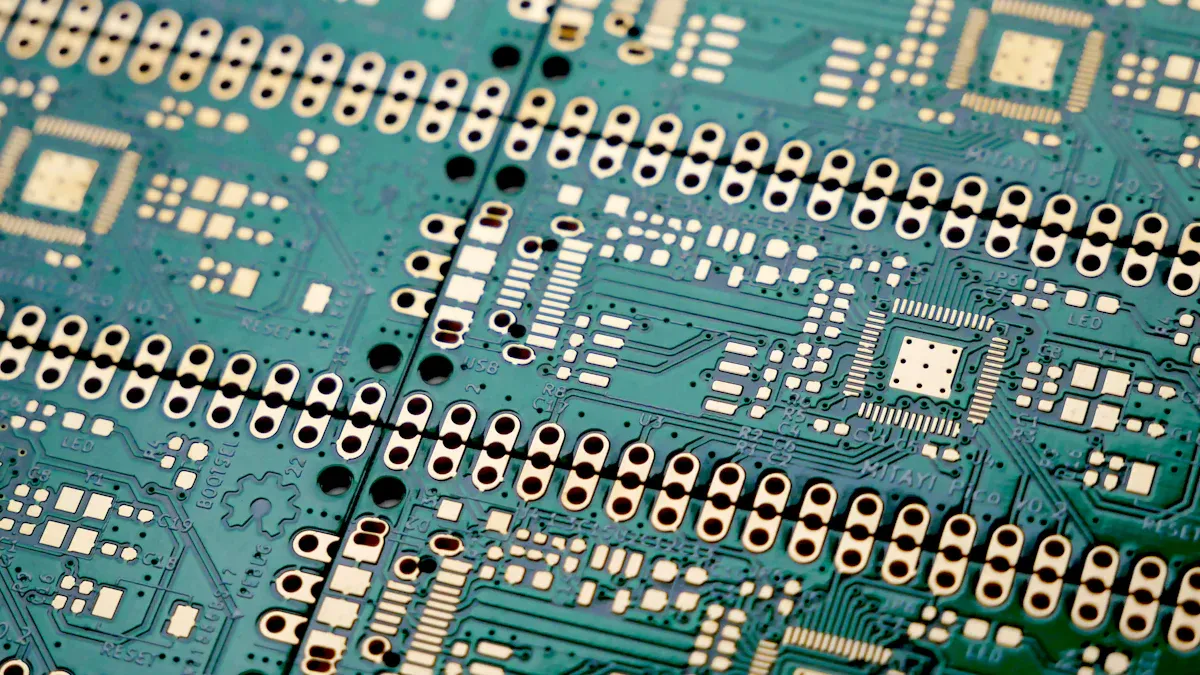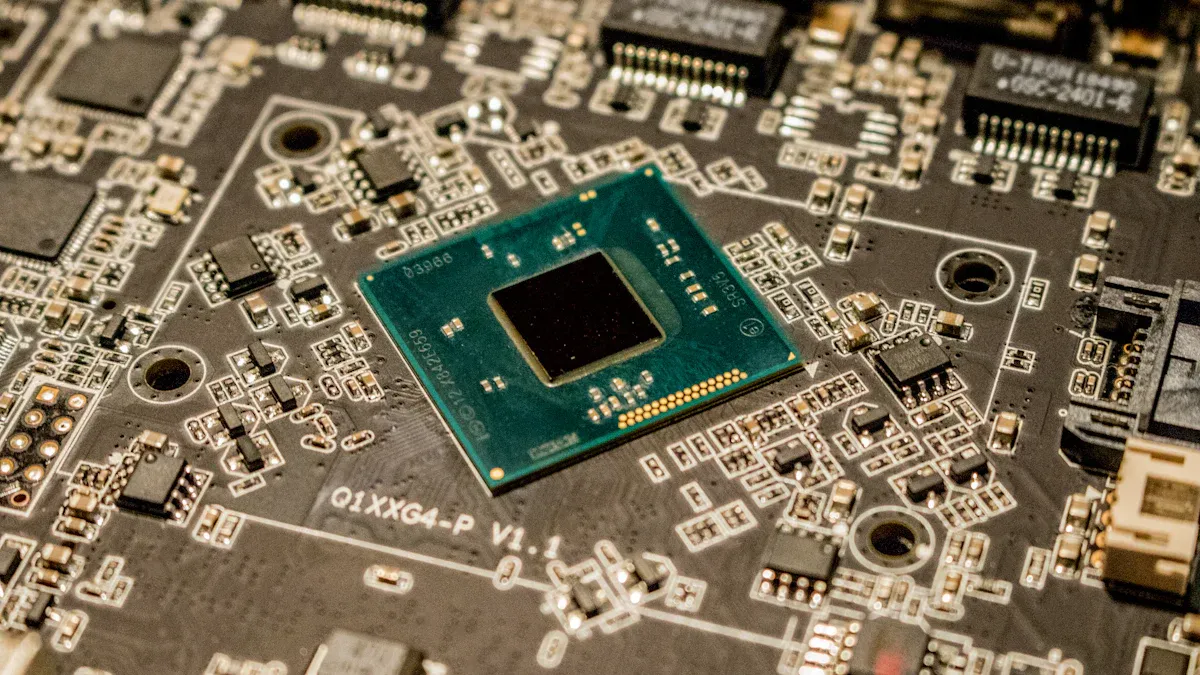The advantages of spraying using electrostatic technology for solder mask processing in circuit board production

Manufacturers choose electrostatic spraying for solder mask in pcb manufacturing because it delivers clear advantages of spraying. This process increases pcb quality and ensures even solder mask coverage. The advantages of spraying include less solder waste, better pcb manufacturing results, and improved solder mask control. LT CIRCUIT leads in pcb manufacturing innovation.
Key Takeaways
Electrostatic spraying ensures even solder mask coverage on PCBs, preventing defects and improving overall quality.
This method uses solder mask material efficiently, reducing waste and lowering production costs.
Strong adhesion from electrostatic spraying creates reliable solder mask dams that protect PCBs and reduce manufacturing errors.
Advantages of Spraying for Solder Mask

Uniform Coverage
Electrostatic spraying delivers a high-precision application of solder mask in pcb production. This process uses charged particles to apply solder masks evenly across every pcb surface. LT CIRCUIT uses advanced equipment to ensure each solder mask dam forms with consistent thickness. Uniform coverage prevents gaps or thin spots in the solder mask. These gaps can lead to solder bridging or defects during the soldering process. When manufacturers apply solder masks with this method, they achieve reliable solder mask dams that protect every solder pad. The process also helps maintain the integrity of each solder mask bridge, which separates solder mask dams and keeps solder from spreading. LT CIRCUIT’s process ensures that every pcb receives the same level of protection, even on complex designs.
Uniform solder mask coverage reduces the risk of solder mask defects and improves the overall quality of pcb manufacturing.
Material Efficiency
One of the main advantages of spraying is material efficiency. Electrostatic spraying allows manufacturers to apply solder masks with minimal waste. The process targets only the areas that need coverage, so less solder mask material is lost. LT CIRCUIT’s process uses precise controls to reduce overspray and ensure that each solder mask dam is formed with the right amount of material. This efficiency lowers production costs and supports sustainable pcb manufacturing. When manufacturers apply solder masks efficiently, they also reduce the need for rework or repairs. The process helps maintain a clean production environment and supports LT CIRCUIT’s commitment to best practices in the industry.
Material efficiency leads to:
Lower costs for solder mask in pcb production
Less waste during the application process
Improved consistency in solder mask dams and bridges
Superior Adhesion
Superior adhesion is another key benefit of this process. Electrostatic spraying helps solder mask stick firmly to the pcb surface. This strong bond is important for creating reliable solder mask dams, especially on complex pcb layouts. LT CIRCUIT’s expertise in advanced pcb manufacturing ensures that each solder mask application meets strict quality standards. The process creates solder mask dams that resist peeling or lifting during soldering. Strong adhesion also prevents solder from leaking under the solder mask, which can cause short circuits or failures. Manufacturers who apply solder masks with this method see fewer defects and higher yields in their pcb production.
Superior adhesion protects every solder mask dam and bridge, ensuring long-lasting performance for every pcb.
The advantages of spraying using electrostatic technology help LT CIRCUIT deliver high-quality, reliable pcb products. This process supports better solder mask application, efficient use of materials, and strong adhesion for every solder mask dam and bridge.
Solder Mask in PCB Production with LT CIRCUIT
Environmental Benefits
Electrostatic spraying for solder mask in pcb production offers clear environmental advantages. The process uses charged particles to apply solder mask, which reduces overspray and keeps the work area clean. LT CIRCUIT uses advanced nozzle designs and automation to control the spray. This technology lowers emissions and waste. Many companies have seen real results:
Reduced production waste by 30% after switching to automated spraying lines.
Achieved a 50% drop in VOC emissions by using eco-friendly solder mask materials.
Lowered carbon footprint by using water-based coatings.
These improvements help LT CIRCUIT meet strict environmental standards. The process supports a safer workplace and a cleaner environment.
Increased Throughput
LT CIRCUIT’s automated lines boost the speed of solder mask application in pcb manufacturing. The process covers each pcb quickly and evenly. This speed means more pcb units move through production every day. Consistent application of solder mask dams and bridges reduces the need for rework. The process keeps solder mask dams strong and reliable. LT CIRCUIT’s focus on automation ensures every solder mask dam meets quality standards.
Faster production and fewer errors lead to higher output and better results for customers.
Comparison with Traditional Methods
Traditional solder mask application methods often waste material and create uneven coverage. Electrostatic spraying changes this. The process targets only the needed areas, forming precise solder mask dams and bridges. LT CIRCUIT chooses this method because it gives better control over solder mask thickness and placement. The process also keeps solder from spreading where it should not go. This approach leads to fewer defects and higher quality in every pcb.
Electrostatic spraying improves solder mask application in pcb production. LT CIRCUIT uses this technology to deliver strong solder mask dams and bridges. The process ensures each pcb receives even solder mask coverage. Solder mask quality protects every pcb from solder defects. Solder mask efficiency reduces waste. Solder mask adhesion prevents solder issues. Solder mask control increases pcb reliability. Solder mask technology supports sustainable pcb manufacturing. Solder mask methods from LT CIRCUIT set industry standards. Solder mask solutions help every pcb meet strict requirements. Solder mask innovation keeps solder performance high. Solder mask expertise at LT CIRCUIT ensures every pcb achieves top solder results. Solder mask advancements improve pcb quality. Solder mask application with LT CIRCUIT delivers superior solder protection. Solder mask technology reduces solder failures. Solder mask processes at LT CIRCUIT optimize pcb output. Solder mask systems enhance solder reliability. Solder mask improvements drive pcb success. Solder mask solutions from LT CIRCUIT lead the industry. Solder mask coverage prevents solder shorts. Solder mask precision boosts pcb performance. Solder mask excellence at LT CIRCUIT guarantees solder satisfaction.
Discover how LT CIRCUIT’s solder mask technology can upgrade your pcb process and deliver unmatched solder results.
FAQ
What is electrostatic spraying in PCB manufacturing?
Electrostatic spraying uses charged particles to apply coatings. This method ensures even coverage and precise control during the application of the solder mask.
How does LT CIRCUIT improve production efficiency?
LT CIRCUIT uses automated lines. These lines increase speed and reduce errors. Customers receive high-quality PCBs faster.
Is electrostatic spraying environmentally friendly?
Electrostatic spraying reduces waste and emissions. LT CIRCUIT uses eco-friendly materials and advanced controls to support a cleaner production process.
See Also
Comparing Spray And Screen Solder Masks Used In PCBs
How LDI Solder Mask Reduces Bridge Size In PCB Manufacturing
Using Horizontal Copper Sinking Techniques For PCB Fabrication
Key Advantages Of Combining SMT And THT In PCB Assembly
Vacuum Two-Fluid Etching Machines Enhancing Precision In PCB Making
